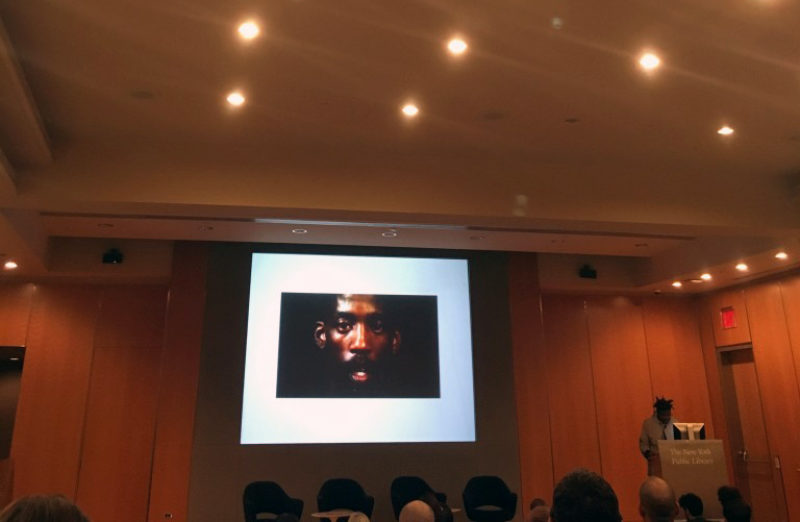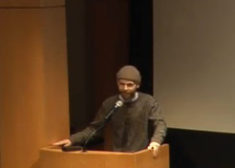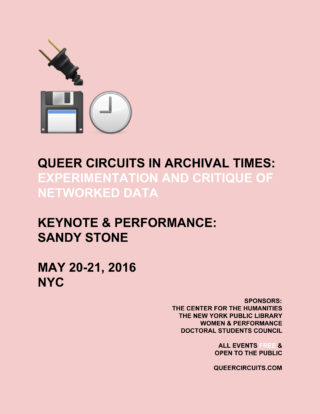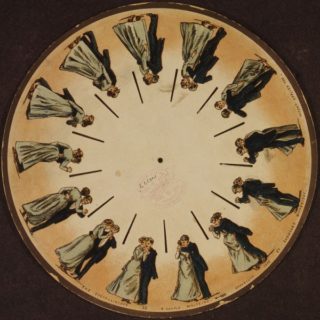“I stand at the threshold of cyberspace and wonder, is it possible that I am unwelcome here, too? Will I be allowed to construct a virtual reality that empowers me? Can invisible men see their own reflections? I’m carrying trauma into cyberspace––violent gestures, a fractured soul, short fuses, dreams of revenge...My primary public characteristics continue to be defined by dreads of me, myths about me and plain old homegrown contempt. All of this confusion is accompanying me into cyberspace; every indignity and humiliation, every anger and suspicion.”
These lines appear in a paragraph of text by Essex Hemphill, in a text called “On the Shores of Cyberspace,” written for the Black Nations / Queer Nations? conference in New York City in 1995, shortly before his death. The line is quoted in and serves as the entrypoint to Tiona McClodden’s project Af·fixing Ceremony: Four Movements for Essex.
I saw McClodden present on this project as part of a panel called “Breaking Into History: AIDS, the Archive, and the Fight Against the Canonization of an Ongoing Epidemic” during the Queer Circuits in Archival Times conference last month.
Any reflections I have on Hemphill’s words, McClodden’s presentation and project, the panel, and the conference now necessarily take place against the backdrop of the mass shooting at Pulse, the Orlando nightclub where 49 primarily brown and black queer men and women were killed last weekend.
Though we are, unsurprisingly, witnessing attempts from every imaginable end of the political spectrum to process (and in the process cover over) this tragedy by proffering explanations for why it happened and arguing policy changes for how to prevent it from happening again, these reactions do none of the work of mourning or remembrance that are needed in the event’s wake. Rather, they attempt to ensure that the grief around the event has an end, that grief will be put to use for that end.
What seemed to be at stake in each of the presentations in the “Breaking Into History” panel was to work against this impulse to bracket historical events into moments that we can more conveniently forget than remember. The presentations were rejoinders to remember, recover, and unconceal histories, doing the work of remembering so as to live with and through the ongoing effects of these histories and the legacies of those lost.
McClodden used Toni Morrison’s term “rememory” in describing her project. Commissioned to produce a digital project on the website of the ICA Philadelphia’s homepage for Day With(out) Art, the international day of action and mourning in response to the AIDS crisis, McClodden presents a ceremony for remembering Hemphill in four parts. Guided by a + sign, the audience moves through a series of words and images of Hemphill, reflections and memories of his friends, and a reimagining of his words and images. When the work was first displayed, the audience had to complete the ceremony before being able to move on to the ICA’s website. McClodden invites the audience into a rememory ritual, where every step of remembrance must be completed in order to proceed to the next, lingering on the beauty, pain, trauma, resistance and grief left behind by Hemphill’s life and that still lives in the world. The process of memory takes work and time, of reading and listening and looking and putting things together.
Fellow panelist Julian de Mayo used the term “memory activism,” while presenting on his research recovering the legacy of the ACT UP Latino caucus, mapping and preserving against the ongoing erasure of archives of Latino/a AIDS activism, including his own digital mapping projects. I was especially struck by de Mayo’s reflections on Marina Alvarez, an AIDS activist, who organized fellow prisoners while incarcerated, then appeared on the first cover of Poz magazine en español, and died without an obituary (not even in Poz). No results come up when you search for her name on the Poz website.
The panel staged this work of memory activism against the violence of forgetting and selective remembrance that enshrines the historical moment of AIDS in the past and silences the reality of the ongoing present for people living with HIV/AIDS, particularly communities of color disproportionately affected by HIV/AIDS.
Panel organizer Ted Kerr introduced the panel with a discussion of his own research and his assertion that certain black, brown, and queer people’s deaths “break into history” from Robert Rayford, who is believed to have had the first known case of HIV/AIDS in the US, to Michael Brown and the many other black men and women killed by the police, who have mobilized the Black Lives Matter movement. These breaks into history reveal an already existing truth, galvanizing a new way of working to resist the violence they reveal. However, often these breaks are sutured by responses of doubt, concealed evidence, and outright lies that recuperate these deaths toward reactionary ends.
In addition to the broader political implications of rememory and memory activism, the form and tone of each of the presentations was directed toward specific acts of memory of specific people, both living and dead. From Ian Bradley Perrin’s presentation of his oral history project with the prolific activist and writer Sarah Schulman, on the numerous moments of activism she has lived through and engaged with, to McClodden’s project on Hemphill, the voices and effects of individual queer artists and activists were at the forefront. Part of the panelists’ work in each presentation was channeling the spirits of these individual people, bringing them into the room and carrying their work forward.
It felt like no coincidence that in Sandy Stone’s keynote presentation the night before, she noted that the first attempts to record sound were attempts to make contact with the dead.
In McClodden’s artist statement for Af·fixing Ceremony, she quotes Charles Nero’s introduction to Hemphill’s book Ceremonies, where Nero quotes Barbara Christian on Toni Morrison’s Beloved, who says the purpose of a “fixing ceremony” is “not merely that of remembrance for the sake of remembrance, but remembrance as the only way to begin the process of healing that psychic wound, which continues to have grave effects on the present.”
Again, Hemphill’s words bear remembering:
“I was counting T-Cells on the shores of cyberspace and feeling some despair...I have miscegenated and mutated, tolerated and assimilated and yet I remain the same in the eyes of those who would fear and despise me. I stand at the threshold of cyberspace and wonder, is it possible that I am unwelcome here, too? Will I be allowed to construct a virtual reality that empowers me? Can invisible men see their own reflections? I’m carrying trauma into cyberspace--violent gestures, a fractured soul, short fuses, dreams of revenge...My primary public characteristics continue to be defined by dreads of me, myths about me and plain old homegrown contempt. All of this confusion is accompanying me into cyberspace; every indignity and humiliation, every anger and suspicion.”



